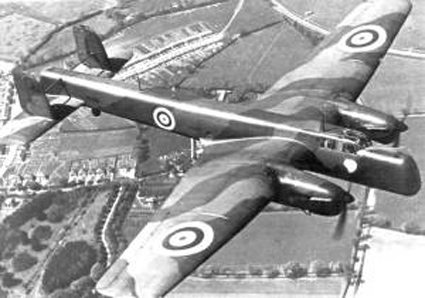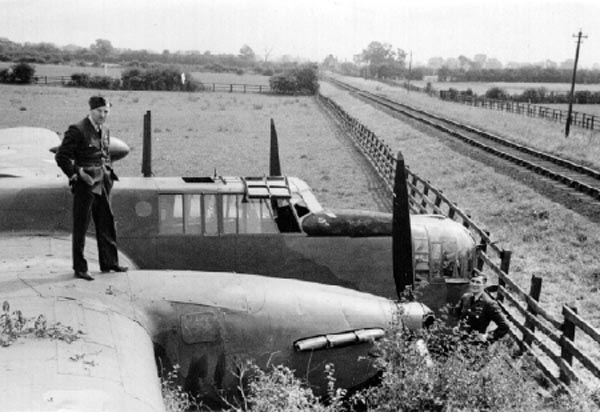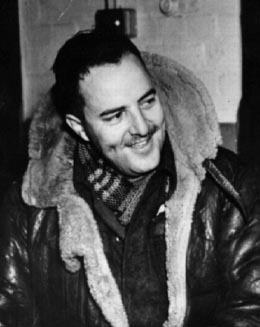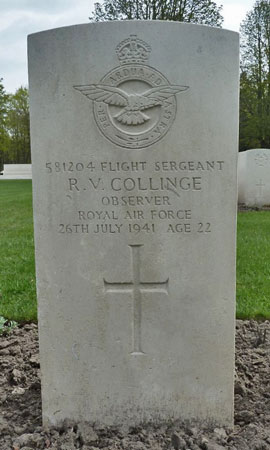Whitley P4941 near Pickering.
On the night of 3rd / 4th August 1940 the crew of this 78 Squadron aircraft were tasked with bombing oil refining targets the Ruhr Valley. Seventy one aircraft had taken part in the raid and three 78 Squadron Whitleys were part of this number. On their return the crews found the Vale of York and the surrounding area covered in fog, two of these
aircraft ran very low on fuel being unable to find an airfield so force-landed in fields. The pilot of this aircraft opted to force-land the aircraft when a
gap in the cloud appeared in the Pickering area. He put the aircraft down with the wheels up in a field down Marton Lane near the Pickering to Kirkbymoorside
stretch of railway line just before the Riseborough cutting. The aircraft took out a hedge row and lost its port rudder. It came to rest with its nose up against
a fence bordering the railway line at 06.30hrs on the 4th August 1940, a couple of miles to the west of Pickering.
Living in Pickering myself this is one of my "local" incidents. I was able to speak to a Pickering resident, Mr Cecil Cook, was a boy living on Westgate,
Pickering in 1940. He recalled the aircraft flying very low over the town, having been asleep the noise of it woke him up and he got up to see it going over.
The aircraft was damaged slightly but the crew were not injured, they apparently walked to a farm and then into Pickering for help with the pilot's Canadian
accent confusing the farmer who's side he was actually on! The Whitley was later removed by road, repaired and flew again.
Pilot - F/O David Robertson RAF (40141), of Calgary, Canada.
Second Pilot - P/O Michael Lomax Stedman RAF (36263), of Dunedin, Otago, New Zealand.
Observer - Sgt Robert Victor Collinge RAF (581204).
Wireless Operator / Air Gunner - Sgt Francis Alan Barton RAF (551110).
Air Gunner - P/O Norman White McLeod RAF (43259).
The Whitley in the field with F/O Robertson on the wing (photo Mr D. Birrell). The above photograph was found on a website detailing the pilot's life and
flying career, the webpage was put together by his son-in-law Mr Dave Birrell and contains a wealth of information on the pilot and life in the early years
of the War in Bomber Command in Yorkshire with some of this reproduced below. "http://www.lancastermuseum.ca:80/s,robertson.html".
A modern day photograph of the site.
Stewart Robertson was born Ogema, Saskatchewan but his family moved to Calgary where he went to school. He worked for the Royal Bank of Canada for nearly two
years before leaving for England and being accepted into the RAF at the end of May 1937. He began training at 2 FTS on 12th July 1937 flying a Blackburn B2 solo
in eleven days, he left here on 4th September 1937 and continued his training. He was awarded his Wings on 3rd January 1938. Prior to the war he is reported to
have flown a number of aircraft in differing roles gaining flying experience. He would eventually solo the Whitley for the first time on 24th February 1940
probably with a training unit in the UK. He force-landed one in March 1940 at Upavon but its identity is yet to be discovered. He was posted to 10 OTU in April
1940 and completed his training. He was then posted to "B" Flight, 51 Squadron on 20th May 1940 and flew his first Operational flight on 24th May 1940 acting as
second pilot to S/Ldr Richard Wildey and in the next twenty seven days they completed thirteen operational flights. On 17th June his aircraft suffered engine
trouble on return from Gelsenkirchen, he was able to return to base on one engine. One flight was to Turin, using the Channel Islands as a forward landing ground,
the aircraft's port engine iced up before crossing the Alps so he returned early. Following these flights with 51 Squadron he was given three weeks leave and
he and his then crew transferred to 78 Squadron at Dishforth on 19th July 1940.
His first flight with 78 Squadron was on the night he arrived, his aircraft was attacked by two fighters and heavy AA fire was reported. He completed a further
twenty five operational flights with 78 Squadron and thus completed a Tour. He was later awarded a DFC for "gallantry and devotion to duty in the execution of air
operations" the recommendation also stated that "this officer has completed 29 operational flights over enemy territory at night. In all circumstances he has
exhibited a high degree of resolution and skill. His determined and cheerful demeanour have set a valuable example to other members of the squadron." His DFC
was presented by King George VI on 8th February 1941. In late November 1940 he was posted to 10 OTU at Abington and training to be an instructor at 24 CAOS at
Moffat, Rhodesia. Whilst stationed here he married in November 1941. He returned to England in October 1942 as a Squadron Leader, he commanded "B" Flight of
149 Squadron at Lakenheath flying Stirlings where he completed his second Tour and was posted to 81 OTU at Tilstock in March 1943, having completed 44 operational
flights. Now a W/C, he was involved in an accident on 26th August 1943. He was in the control tower at Steap, a satellite airfield of Tilstock, when Whitley HF628
crashed into it, two on the aircraft were killed and he and five others were injured. A re-organisation of the RAF would then see 81 OTU transfer to 38 Group
leading up to the D-Day landings. He took command of the Unit and saw out the War in this role and would later return home to Canada. On 19th March 1948 he joined
403 RCAF Reserve Squadron until December the following year when he made his final flight in a Mustang. He had flown 19 different types of aircraft and had
amassed 1887 hours flying time.
Sgt Robert Collinge was Mentioned in Despatches on as yet unknown date. He was later posted to 35 Squadron and on 26th July 1941 when he and all on board
Halifax L9507 were killed when the aircraft crashed in Germany on Ops to Berlin. The whole of his crew on this flight are buried in Berlin War Cemetery. He
was twenty two years old. I thank Mr Graham Sharpe for the photograph of his gravestone.
Norman McLeod (pictured above) received a commission to P/O on Probation on 7th April 1940. He was posted from 78 Squadron to the CGS in September 1940 to
undertake a gunnery training course and later returned to 78 Squadron. He was promoted to F/O on 7th April 1941 and later to F/Lt on 7th April 1942. On 24th July 1941 he was flying with 76 Squadron in Halifax L9529 when the aircraft was badly damaged by enemy aircraft while attacking the Scharnhorst at La Pallice. He was able to bale out before the aircraft crashed but became a PoW. Post-WW2 he continued his service until May 1956 when he relinquished his commission, retaining his rank of Flight Lieutenant.




Michael Stedman received a commission on 9th April 1940 to P/O. He was sadly reported missing on 14th December 1940 as the pilot of Whitley N1485 on Ops
to Kiel. The crew attempted to abandon the aircraft over The Wash but he was never found and is commemorated on the Runnymede Memorial. He was twenty years old.



Francis Barton received the DFM for service with 78 Squadron, Gazetted on 9th May 1941. He was later Mentioned in Despatches on 24th September 1941.
Whitley P4941 was built to contract 75147/38 by Armstrong Whitworth Ltd at Baginton and was delivered directly to 58 Squadron at Linton-on-Ouse on 5th April 1940
and was transferred to 78 Squadron at Dishforth on unknown date. Following its damage at Pickering on 4th August 1940 it was initially inspected on site and
given Cat.W damage but was then taken away and further inspected and Re-Cat.R/FB. After repair in works and a period in storage it was later issued to 10 OTU at
Abingdon in 1941. It transferred to 42 OTU at Ashbourne in March 1943 and was eventually struck off charge on 29th August 1944.